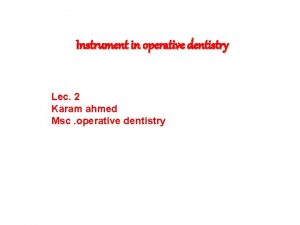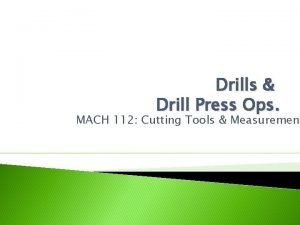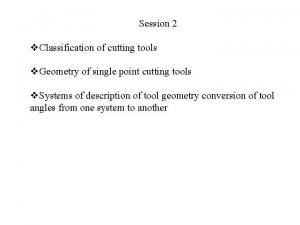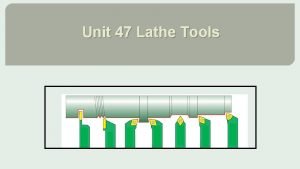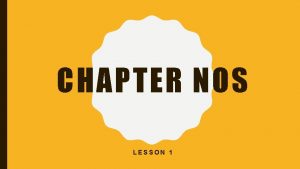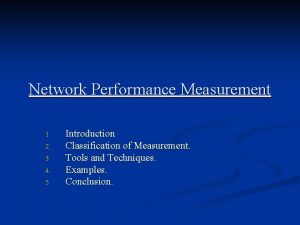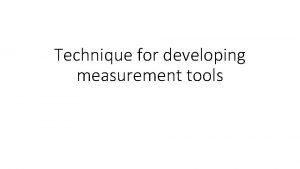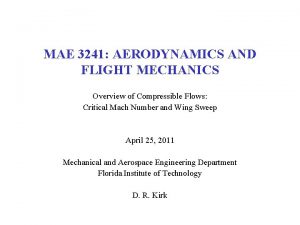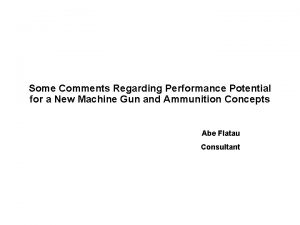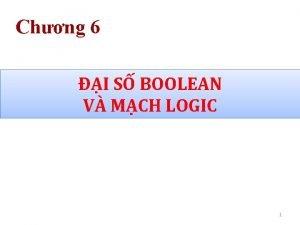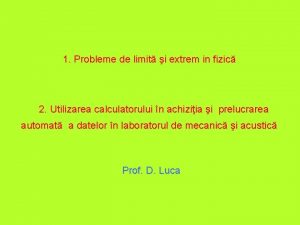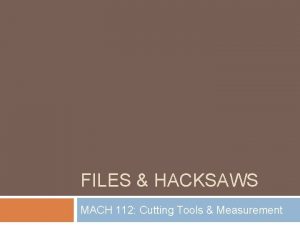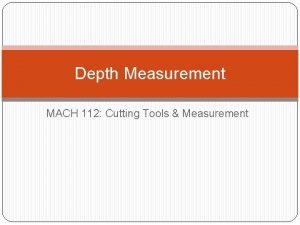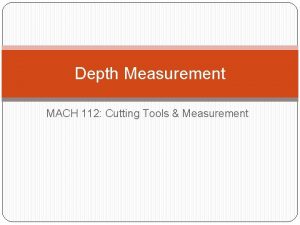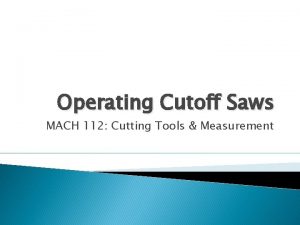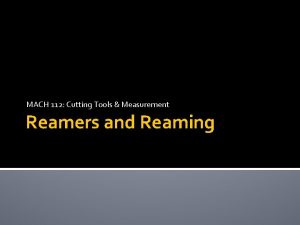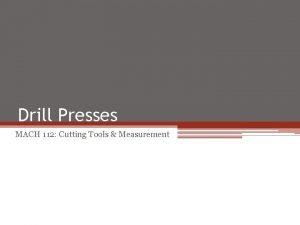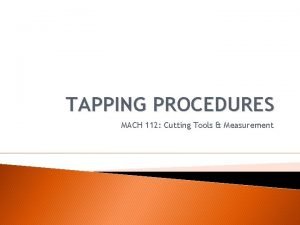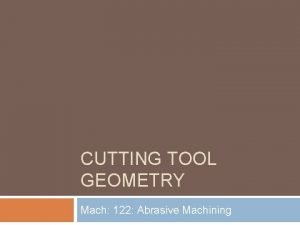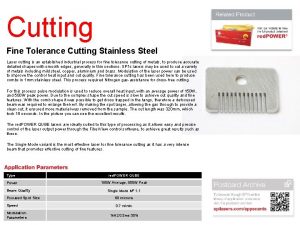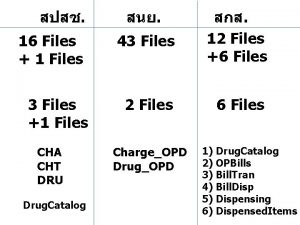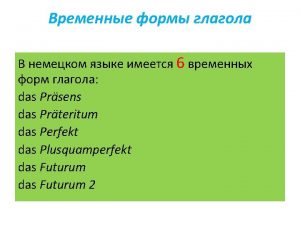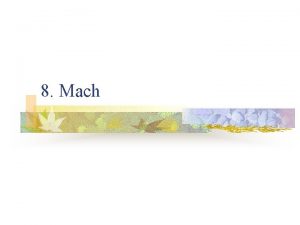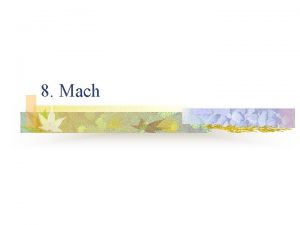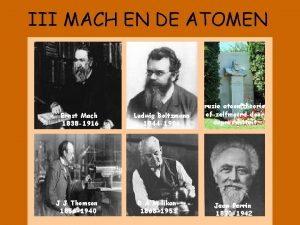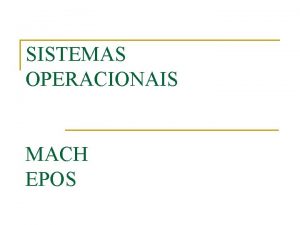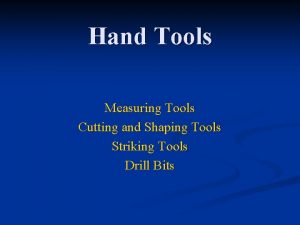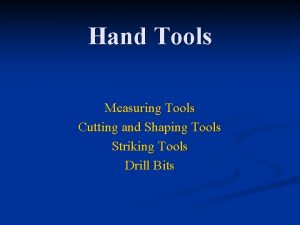FILES HACKSAWS MACH 112 Cutting Tools Measurement FILES







































- Slides: 39

FILES & HACKSAWS MACH 112: Cutting Tools & Measurement

FILES Introduction Files are often used to remove burrs or sharp edges or as a final fitting operation. Intricate parts or shapes are often produced entirely by using files. � In this unit you are introduced to the types & uses of files in metalworking. atab

OBJECTIVES Identify eight common files shapes and some of their uses.

FILES a Files are made in lengths ranging from 4 to 18 in. � Measured from heel to point, tang excluded. Parts of a file. Files are made in several different lengths.

FILES Types of Files a Most files are made from high-carbon steel and are heat-treated to the correct hardness range, in four different cuts: single, double, curved tooth & rasp. � Curved tooth files give excellent results on soft materials. Files also vary in their coarseness: rough, coarse, bastard, second cut, smooth, and dead smooth. � Files most often used are the bastard, second cut,

FILES Types of Files a For maximum metal removal, use a double-cut file. � For a smooth finish, a single-cut file is recommended. Fig. B-76 These files are both bastard cut, but as they are different lengths, they have different coarsenesses.

FILES Types of Files Curved tooth files are best at removing soft material. Curved tooth file shapes are flat, half-round, pillar, and square, cut very freely & remove material rapidly. Fig. B-90 Curved tooth files are used on soft metals. a

FILES a Types of Files are either blunt or tapered. Blunt and tapered file shapes. Mill file.

FILES a File Shapes 1) Flat files are usually double-cut. 1) Double-cut files are used when fast cutting is needed. 2) Mill Files are tapered for the last third of its length and are single-cut 2) Pillar files have a narrower but thicker cross section than flat files. The flat file is usually a double-cut file. Two pillar files.

FILES a File Shapes 3) Square files usually are double cut and are used to file in keyseats, slots, or holes. 4) Warding files are used if a thin file is needed with a rectangular cross section. � This file is often used by locksmiths when filing notches into locks and keys. Square file. Warding file.

FILES a File Shapes 5) Knife files are used in narrow slots. 6) Three-square files, also called triangular files, are triangular in shape with faces at 60 -degree angles to each other. Three-square files are used for filing angles between 60 & 90 degrees. Knife file. Used for filing internal angles between 60 & 90 degrees as well as to make sharp corners in square holes.

FILES a File Shapes 7) Half-round files because of their tapered construction, can be used to file many different radii. 8) Round files are used to file small radii or to enlarge holes. Fig. B-86 Half-round files are used for internal curves. Fig. B-87 Round files are used to file a small radius or to enlarge a hole.

FILES Specialty Files a Swiss pattern files are manufactured to much closer tolerances than American pattern files but are made in the same shapes. Swiss pattern files range in length from 3 to 10 in. Coarseness is indicated by numbers from 00 (coarse) to 6 (fine). Set of Swiss pattern files. Since these small files are very delicate and can be broken quite easily, great care must be exercised in their use.

FILES Specialty Files a Another Swiss pattern file is the die sinkers’ riffler. � Double-ended � Used with cutting surfaces on either end. by tool & die makers, mold makers & workers engaged in precision filing on delicate instruments. Die sinker’s rifflers.

FILES Specialty Files a Thread files are used to clean up & reshape damaged threads. � They are square in cross section & have eight different thread pitches on each file. � The thread file is most effectively used when held or stroked against the thread while it is rotating in a lathe. Fig. B-92 Thread files.

FILES Care and Use of Files do an efficient job of cutting only while sharp. Files & their teeth are hard and brittle. � Do a not use a file as a hammer or as a pry bar. Files should be stored so they are not in contact with any other file. � One file will break teeth the other. Fig. B-93 Fileson should be kept neatly arranged so that they will not strike one another & damage cutting edges.

FILES Care and Use of Files Teeth on files will also break if too much pressure is put on them while filing. � If not enough pressure is applied while filing, the file only rubs the workpiece and dulls the teeth. � Dulling of teeth is also caused by filing hard materials or by filing too fast. a

FILES Care and Use of Files a Too much pressure on a new file may cause pinning. � The result is deep scratches on the work surface. If the pins cannot be removed with a file card, try a piece of brass, copper, or mild steel, and push it through the teeth. Fig. B-94 Using a file card to clean a file.

FILES Care and Use of Files a A file will not pin as much if some blackboard chalk is applied to the face. Using chalk on the file to help reduce pinning.

FILES Care and Use of Files Never use a file without a file handle, or the pointed tang may cause serious hand or wrist injury. A file should never be used without a file handle. This style of handle is designed to screw on rather than be driven on the tang. a

FILES Care and Use of Files A file cuts only on the forward stroke, no pressure should be applied on the return stroke. � Letting the file drag over the workpiece on the return stroke helps release the small chips. � This can dull the file & scratch the part, so do cautiously. a

FILES Care and Use of Files a Figure B-98 shows how a file should be held to file a flat surface. A smooth finish is usually obtained by draw filing (Figure B-99), whereby a single-cut file is held with both hands and drawn back & forth on a workpiece. Fig. B-98 Proper filing position. Fig. B-99 Draw filing.

FILES Care and Use of Files a When a round file or half-round file is used, the forward stroke should also include a clockwise rotation for deeper cuts and a smoother finish. People who are filing tend to run their hands or fingers over a newly filed surface. � This deposits a thin coat of skin oil on the surface, and when filing is resumed, the file will not cut for several strokes but will only slip over the surface, causing the file to dull more quickly.

File Safety Never use file without handle. Clean file with a file card, not your hand. Do not clean a file by slapping it on the bench. Never use files for prying tasks. Never hammer on or with a file.

HACKSAWS Introduction The hacksaw is one of the more frequently used hand tools and is a relatively simple tool to use � Facts & rules presented in this unit will help you improve your use of the hacksaw.

OBJECTIVESshould be able to… Identify, select, and use hand hacksaws.

HACKSAWS Hacksaw Design The hacksaw consists of three parts: � The frame, the handle, and the saw blade. Fig. B-65 Parts of a hacksaw. • Frames are either the solid or adjustable type. – Solid frame can be used with only one saw blade length. – Adjustable frame can be used with blades 8 -12” in length. a

HACKSAWS a Hacksaw Design The blade can be mounted to cut in line with the frame or at a right angle to the frame. Fig. B-66 Straight sawing with a hacksaw. Fig. B-67 Sawing with the blade set at 90 degrees to the frame.

HACKSAWS a Hacksaw Design Most hacksaw blades are made from high-speed steel and in standard lengths of 8, 10, and 12 in. � Blades are generally 1/2 wide &. 025 in. thick. The kerf, or cut, produced by the hacksaw is wider than the. 025 -in. thickness of the blade because of the set of the teeth Set refers to the bending of teeth outward from the blade itself. Two kinds of sets are found on hand hacksaw blades Fig. B-68 The kerf is wider than the blade because of the set of the teeth.

HACKSAWS a Hacksaw Design The first is the straight or alternate set, in which one tooth is bent to the right and the next tooth to the left for the length of the blade. The second is the wavy set, in which a number of teeth are gradually bent to the right, and then left. Fig. B-69 Straight (alternate) set. Fig. B-70 Wavy set.

HACKSAWS Hacksaw Design Spacing of the teeth on a hand hacksaw blade is called pitch, expressed in teeth per inch of length. � Standard pitches are 14, 18, 24, and 32 teeth per inch, with the 18 -pitch blade used as a generalpurpose blade. Fig. B-71 The pitch of the blade is expressed as the number of teeth per inch. a

HACKSAWS Handsaw Use a Hand hacksaw blades fall into two categories: soft-backed or flexible blades and all-hard blades. � On the flexible blades only the teeth are hardened, the back being tough and flexible. � The all-hard blade is hard and very brittle, and should be used only where the workpiece can be rigidly supported, as in a vise.

HACKSAWS Handsaw Use a The blades are mounted in the frame with the teeth pointing away from the handle so that the hacksaw cuts only on the forward stroke. � No cutting pressure should be applied to the blade on the return stroke, as this tends to dull the teeth. A cut on a workpiece should be started with only light cutting pressure, with the thumb or fingers on one hand acting as a guide for the blade. � Sometimes it helps to start a blade in a small veenotch filed into the workpiece.

HACKSAWS a Handsaw Use The set on the new blade is wider than the old kerf. Forcing the new blade into an old cut will ruin it immediately by wearing the set down. Teeth will dull if too fast a cutting stroke is used. Sawing speed should be 40 -60 strokes per minute. A new blade must be started on the opposite side of the work, not in the kerf made by the old blade.

HACKSAWS Handsaw Use a Work should be positioned in a vise so that the saw cut is vertical, making it easier for the saw to follow a straight line. When a workpiece is supported in a vise, make sure cutting is done close to the vise jaws for a rigid setup, free of chatter. The workpiece is being sawed close to the vise to present vibration and chatter.

HACKSAWS Handsaw Use a At the end of a cut, before the pieces completely part, reduce cutting pressure. To saw thin material, sandwich it between two pieces of wood for a straight cut. Avoid bending saw blades, because they are likely to break, and shatter in all directions.

REVIEW QUESTIONS Identify eight common files shapes. What is the tang of a file? Files vary in coarseness, what are three most common? What type of cut should be selected for course filing? Curved tooth files are best at removing what type of material? Name the eight most common file shapes. What are Swiss files and what are riffler files? How should files be stored? What is pinning and how is it fixed?

REVIEW QUESTIONS What precaution must always be taken when using a file? What are three main parts of a hacksaw? What is a saw kerf? What is a blade set? Name two types of blade sets. What is meant by tooth pitch? What are the two categories of hacksaw blades? Which way must the teeth be pointed when using a hacksaw?

QUESTIONS?
 6 sin 112 5° sin 22 5°
6 sin 112 5° sin 22 5° Dot powai files are binary files
Dot powai files are binary files Cjis security & awareness certification
Cjis security & awareness certification Cjis meaning
Cjis meaning Sewing tools measuring tools
Sewing tools measuring tools Orthogonal cutting is dimensional metal cutting
Orthogonal cutting is dimensional metal cutting Dental instruments classification
Dental instruments classification Modified palm and thumb grasp
Modified palm and thumb grasp Basic chairside instruments and tray systems
Basic chairside instruments and tray systems Ribbon shears floral design
Ribbon shears floral design Fixtures related to cutting tools
Fixtures related to cutting tools Holding devices in woodwork
Holding devices in woodwork Chapter 10 plasma arc cutting
Chapter 10 plasma arc cutting Turning tool in a workshop
Turning tool in a workshop Mach drills
Mach drills Double point cutting tool
Double point cutting tool In centerless grinding workpiece is supported by mcq
In centerless grinding workpiece is supported by mcq Types of lathe tools
Types of lathe tools Network performance measurement tools
Network performance measurement tools Lesson 1 understanding science answer key
Lesson 1 understanding science answer key Network performance measurement tools
Network performance measurement tools Geometric measurement tools
Geometric measurement tools Lesson 2 measurement and scientific tools
Lesson 2 measurement and scientific tools Non precision instruments examples
Non precision instruments examples Risk measurement tools
Risk measurement tools Weather measurement tools
Weather measurement tools Engine measurement tools
Engine measurement tools Lesson outline lesson 1: understanding science answer key
Lesson outline lesson 1: understanding science answer key The technique of developing and
The technique of developing and Irene mach
Irene mach Mach number formula
Mach number formula Mach number
Mach number Magda mach
Magda mach Bảng chân trị xor
Bảng chân trị xor Pendulul mach
Pendulul mach Process management in mach
Process management in mach Mach-zehnder-interferometer leifi
Mach-zehnder-interferometer leifi Khi cho nam châm chuyển qua một mạch kín
Khi cho nam châm chuyển qua một mạch kín Mach iv test
Mach iv test Vẽ đồ thị họ đặc tuyến ra ic
Vẽ đồ thị họ đặc tuyến ra ic







